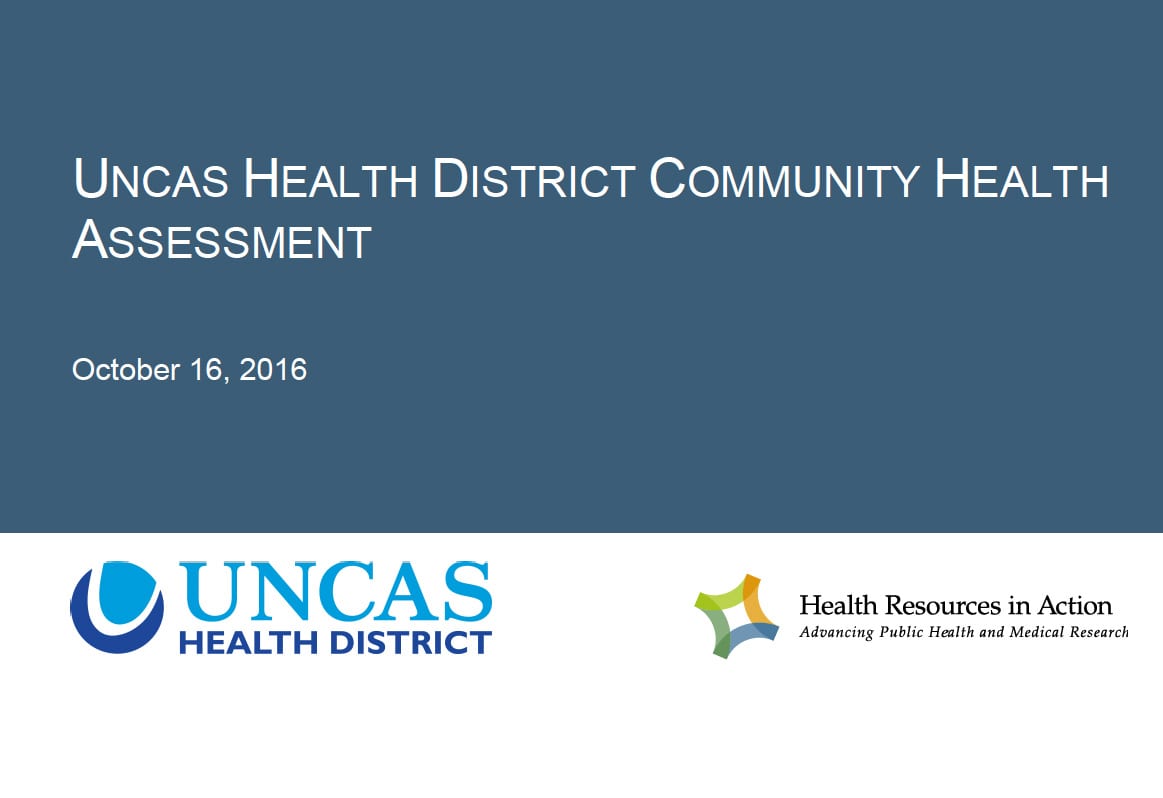UHD Community Health Assessment
Executive Summary
Introduction
The Uncas Health District is a non-profit organization that provides local public health services to the municipalities of Bozrah, Griswold, Lebanon, Lisbon, Montville, Norwich, Salem, Sprague, and Voluntown in New London County, Connecticut. The Uncas Health District is undertaking a community health assessment (CHA) to enhance understanding of the health of residents in the communities served by the Uncas Health District and to gain insight regarding how identified health needs are currently being addressed. The overarching goal of the CHA process is to provide a broad portrait of the health of the communities served by Uncas Health District. The CHA will provide a foundation for data-driven community health improvement planning (CHIP) efforts to inform a strategic plan to promote and improve community health. The community served by Uncas Health District was defined as the towns of Bozrah, Griswold, Lebanon, Lisbon, Montville, Norwich, Salem, Sprague, and Voluntown.
Community Health Assessment Methods
Guided by a social determinants of health approach, the Uncas Health District CHA aims to provide a portrait of community health for its specific service area. To develop an Uncas service area-specific CHA, Uncas Health District contracted with Health Resources in Action (HRiA), a non-profit public health consultancy organization, to conduct the CHA. HRiA reviewed existing secondary data from local, state, and national sources. HRiA conducted qualitative data collection with hospital and public health administrators and with focus group participants representing the firefighter/emergency responder and senior communities to understand their perceptions of community strengths and assets, priority health concerns, and suggestions for future programming and services to promote community health. A total of 31 individuals were engaged in key informant interviews (8 people) and focus groups (23 people).
Key Findings
The following provides a brief overview of key findings that emerged from this assessment that were identified as priority areas for the community health improvement process.
Substance Use
Opioid Use. Several focus group participants and key informants noted rising misuse and abuse of opioids in the region across age groups. While perceptions varied regarding the geographic distribution of opioid issues in the Uncas Health District, several residents characterized this as an issue that affected the region “regardless of geography or town” and one that was particularly acute in New London County. Reports of opioid misuse and abuse included both heroin and prescription opioids. Residents attributed substance
use to stress and untreated mental health issues. From 2009 to 2014, the rate of deaths due to opioids was highest in Norwich, Salem, and Sprague. In 2011-2013, across Connecticut the rate of heroin overdose deaths was highest in New London County (6.21-7.50 deaths per 100,000 population), an increase over the rate for 2008-2010 (2.31-3.60 deaths per 100,000 population). In 2011-2013, New London County was among the three Connecticut counties with the highest rate of deaths due to prescription drug overdose (3.51-4.00 deaths per 100,000 population). The rate of deaths due to prescription drug overdose in New London County increased from 2.01-2.50 deaths per 100,000 population in 2008-2010 to 3.51-4.00 deaths per 100,000 population in 2011-2013.
Opioid-Related Deaths, by Town, 2009-2014
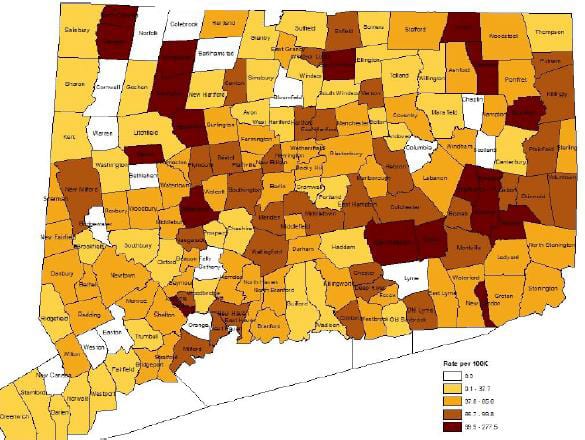
Data Source: Connecticut Medical Examiners Office, “OD Brief Presentation January 2016 – AIDS CT”, as reported in “Prescription Opioid and Heroin Drug Overdoses in Connecticut .Residents: Epidemiology and Trends” presentation by the Office of Injury Prevention, Connecticut DPH.
Note: Rate is per 100,000 population; 2009-2014.
Percent Reporting Did Not Have Enough Money for Food in Past Year, by Income, Norwich, 2015
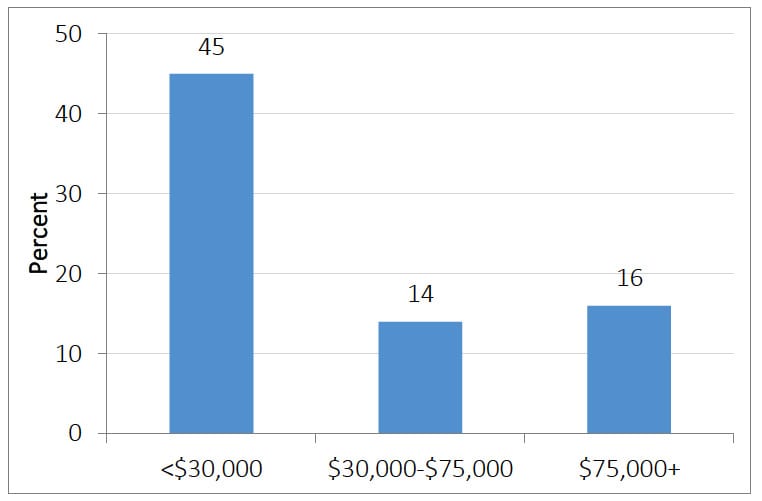
Percent Reporting Did Not Have Enough Money for Food in Past Year, by Income, Norwich, 2015
Chronic Disease Prevention
Healthy Eating. Several key informants and focus group participants described food insecurity as a common health concern for low-income residents. As articulated by one focus group participant, “a lot of people use the food pantry.” Focus group participants also cited a desire for more grocery stores and access to healthy, locally sourced foods. In 2012-2014, the food environment index score in New London County (7.8) was similar to the index score for Connecticut (7.9), indicating a moderately favorable context of access to healthy food for residents of New London County. However, in 2015 approximately two in ten Norwich residents (22%) reported not having enough money to purchase food that they or their family needed, compared to approximately one in ten Connecticut residents (12%). Reports of food insecurity was greatest among lower income residents: 45% of Norwich residents with incomes below $30,000 reported that they did not have enough money for food in the past year, compared to 14% of residents with incomes between $30,000-$75,000 and 16% of residents with incomes above $75,000.
Tobacco Use
Tobacco use was a concern that some focus group participants and key informants described as being longstanding health issues in the region. A few participants commented that they believed that tobacco use, although more common, was not getting the enough attention given the increase in concern around opioid use in the region. According to the BRFSS, in 2011-2014 22% of Uncas Health District adults reported smoking. A reported 63% of current smokers in Norwich reported at least one attempt to quit smoking in the past year, compared to 55% of Connecticut residents. Among current smokers in Norwich, 71% of those with incomes below $30,000 reported an attempt to quit smoking in the past year, followed by those with incomes above $75,000 (59%) and persons with incomes $30,000-$75,000 (51%).
Percent of Adults Who Smoked, Connecticut vs. Uncas Health District, 2011-2014
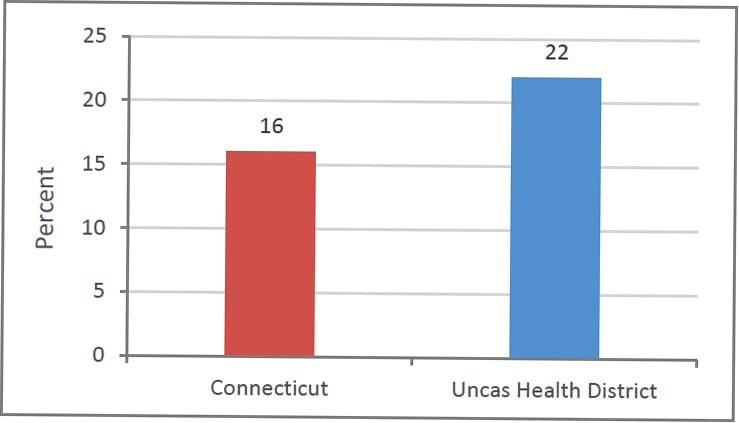
Data Source: Behavioral Risk Factor Surveillance System 2011-2014, as reported by CT DPH.
Cancer Incidence Rate, by Cancer Site, Connecticut vs. New London County, 2008-2011
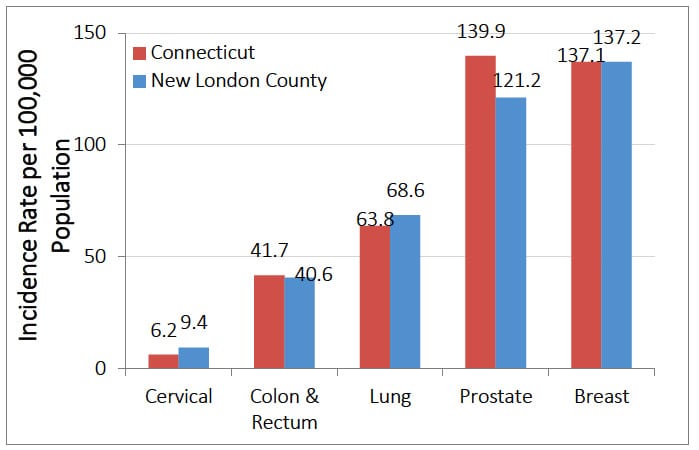
Data Source: National Cancer Institute Surveillance, Epidemiology, and End Results Program (SEER), 2008-2011; As reported in Community Commons.
Cancer
While focus group participants did not identify cancer as a priority health concern, key informants cited cancer as a persistent community health concern. In New London County in 2008-2011 the cancer incidence rate was highest for cancer of the breast (137.2 per 100,000 population) and prostate (121.2 per 100,000 population). The cancer incidence rate was higher in New London County than Connecticut for cancer of the cervix (9.4 per 100,000 population vs. 6.2 per 100,000 population) and lung (68.6 per 100,000 population vs. 63.8 per 100,000 population). The incidence rate for cancer of the prostate was lower in New London County (121.2 per 100,000 population) than Connecticut (139.9 per 100,000 population), while rates were similar for the County and State for cancer of the colon and rectum and breast.
Health Care Access: Transportation
While residents described primary health care services as relatively accessible in the region, some noted that dentists and specialists were more common in higher-income or more populated towns. Residents cited primary care access as a challenge for vulnerable populations, including low-income and elderly residents. Limited access to behavioral health providers for vulnerable populations was also a community concern. As a related issue, some residents noted that public transportation seemed to be more available in towns outside of the Uncas Health District, while few noted alternative transportation options in the towns served by the Uncas Health District, particularly for vulnerable populations such as senior and low-income residents. For example, one key informant remarked, “[The] elderly who are part of the senior center and live in Norwich have access to transportation, but it’s specific to elderly and they have to live in Norwich. What about those in other communities?” The majority of residents across towns served by Uncas Health District drove alone or carpooled to work.
“Many people need to travel out of town for provider services and people who don’t have cars experience a big challenge. Many elderly don’t have family around to help them with transportation and they have a real challenge getting around.”
– Key informant
Priorities for the Community Health Improvement Plan
Based on findings from the Community Health Assessment, Uncas Health District identified the following community health improvement plan priorities: (1) addressing opioid use and abuse; (2) preventing chronic disease by improving access to nutritional foods and healthy eating, reducing tobacco use, and improving cancer prevention and cancer-related outcomes; and (3) reducing transportation-related barriers to health care access. These priorities align well with the community health improvement priorities identified by the Healthy Connecticut 2020 State Health Improvement Plan and the Ledge Light Health District for Southeastern Connecticut. The alignment of these priorities across the region provides opportunities for synergies between Uncas Health District’s approach to promoting and improving the health of Uncas Health District residents and other local and state-wide initiatives.
